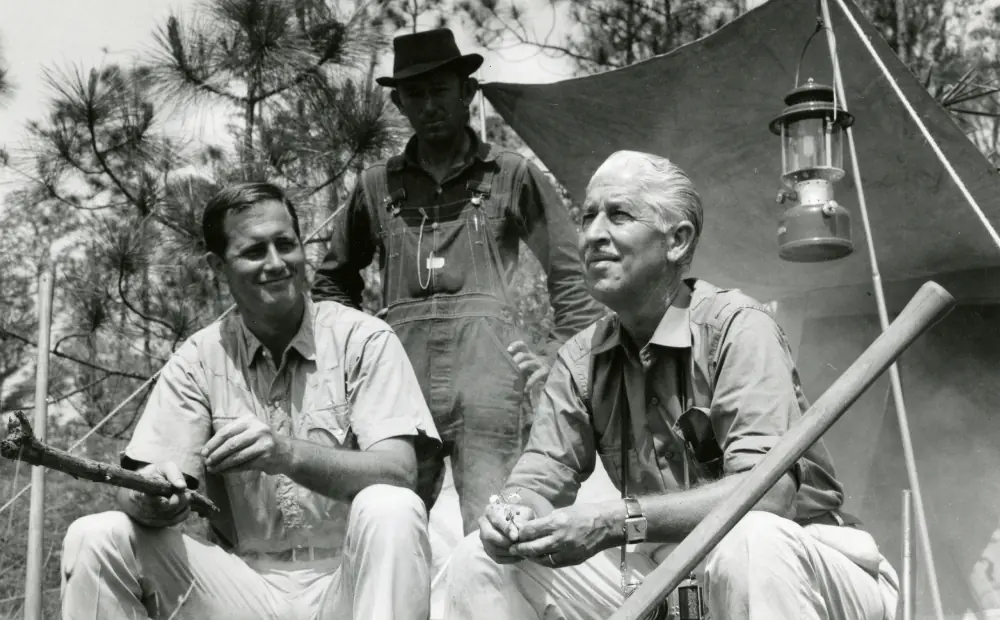0:03
40 years ago, the fate of the California condor was uncertain.
0:08
Lead poisoning and habitat loss had decimated their numbers.
0:12
In 1987, they were officially declared extinct in the wild, but against all odds and 11th hour plan was literally hatched to save them.
0:24
The US Fish and Wildlife Service has initiated a condor recovery program to breed the remaining California condors in captivity.
0:34
The last 22 California condors on Earth were captured from these parents.
0:40
Baby Condor chicks were painstakingly raised by conservation scientists and eventually released back into the wild.
0:48
Today, there are approximately 500 condors soaring the skies of California.
0:58
I'm here where it all began at the San Diego Zoo Safari Park.
1:02
Now, California condors are still critically endangered and the work continues.
1:06
So I'll be teaming up with lead wildlife care specialist Ron Webb.
1:10
He's going to show me the ropes.
1:12
So this is our hatching trailer, and there's movement inside this.
1:16
Is that the chicks?
1:17
Yeah, that's the beak right there.
1:18
California condor chicks will actually fledge or leave the nest at about 150 days, five months or so out in the wild.
1:24
Kids are with mom and dad for about a year and a half, about 18 months.
1:28
Good luck, little one.
1:29
See you on the other side.
1:33
So what is all this?
1:35
Yes, cameras.
1:36
And then also the the pen cameras.
1:38
So we're spying on the condors, but for their own.
1:42
It's rude, but it's for their benefit.
1:43
Yeah.
1:44
So there's a chick in this one.
1:47
Oh, wow.
1:48
This bird's name is Ewu.
1:49
24 days old.
1:51
Wow.
1:51
So that's the first, our first chick to hatch this year.
1:54
And it's doing what baby animals do, so much of which is sleeping.
1:58
Lots of sleeping, lots of growing.
1:59
Yeah, after being raised for a year and a half in human care, these young condors will be released into the wild.
2:11
A network of California agencies collaborate to prepare each new generation for their big day.
2:18
Peter went to the other end of California, 800 miles north, to see this incredible work for himself.
2:26
A young condor has a lot to learn.
2:29
Social development is a critical step in their fight for survival.
2:34
Chris West and Tiana Williams have trained and released captive bred condors since 2008.
2:42
Initially we were releasing birds at pretty young ages.
2:45
Fledging age seemed a reasonable age to put condors out there.
2:49
But what we weren't thinking of was that a condor that fledges out of a nest still hangs around with its parents for like a year and a half.
2:57
They are parents who contribute very heavily to the well-being and health of their child, both male and female.
3:03
They recognize the important role of being a parent, of being a good parent, and what that means for the future of not only their offspring, but of the flock.
3:11
The birds that we're releasing don't have the benefit of following their parents around.
3:15
So the captive rearing facilities not only are breeding condors, but they're also acting as nursery schools for these birds.
3:23
They can immediately socialize and integrate with the wild flying birds.
3:27
Those birds can help them learn how to be a condor.
3:32
Today, Chris and Tiana are set to release a juvenile female Condor identified by number a zero.
3:40
The first step is to find a zero, another condor to emulate.
3:44
So Chris and I set out to track 2 previously released birds, identified by numbers A2 and A3.
3:52
If one of them is nearby, we can attract it to the pen with a delicious animal carcass.
3:58
We're hoping to be able to release a 0 into a two and a three being at the carcass feeding, which would make her much more likely to head out.
4:05
I think.
4:05
We have no idea if that's how it's going to work out.
4:08
Not only does a 0 need a friend by her side, but weather conditions need to be just right as well.
4:15
When they're released into the wild.
4:17
They still don't know how to fly.
4:19
They've never had that experience.
4:21
If she got up above the Ridge and she doesn't know how to fly yet and got caught by a gust, that would be really detrimental to her.
4:29
We want to put her out when conditions are ideal to make it as softer release as possible to give her the best chance.
4:35
If wind conditions are too strong, 80 zero could be pushed to the ground outside the fence line and unable to get back in.
4:43
She was ready to go out today but the forecast was for highwind.
4:48
Doesn't seem super windy.
4:49
So no, all we need now is a wild condor.
4:54
And right on cue, Chris picks up a signal from a radio caller.
5:00
So this right here is bird A3 and A2 is hanging out with a three, so pretty similar.
5:08
So that's up over our right shoulder here.












